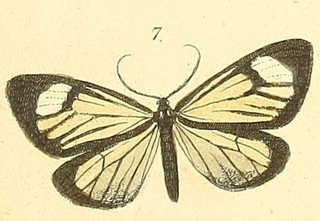
Oenosandridae is a family of Australian noctuoid moths. Genera include:

Notodontidae is a family of moths with approximately 3,800 known species. The family was described by James Francis Stephens in 1829. Moths of this family are found in all parts of the world, but they are most concentrated in tropical areas, especially in the New World.
Doidae is a family of Lepidoptera first described by Julian P. Donahue and John W. Brown in 1987. It is sometimes treated as a subfamily of the Notodontidae. Species have been placed in the Arctiidae, Lymantriidae and the Dioptidae.
Eremonidia is a monotypic moth genus of the family Notodontidae. Its only species, Eremonidia mirifica, is known from two mountain ranges in the south-western part of the Dominican Republic. Both the genus and species were first described by John E. Rawlins and James S. Miller in 2008.
Scotura bugabensis is a moth of the family Notodontidae first described by Druce in 1895. It is found from Costa Rica south to south-eastern Peru at elevations between 0 and 600 meters
Oricia homalochroa is a moth of the family Notodontidae first described by Cajetan and Rudolf Felder in 1874. It is found from Guatemala south to Panama.
Oricia truncata is a moth of the family Notodontidae. It is found from Mexico south to Panama.
Xenorma cytheris is a moth of the family Notodontidae first described by Herbert Druce in 1891. It is widely distributed in Central America, occurring from Veracruz, Mexico, south to Costa Rica.
Polypoetes rufipuncta is a moth of the family Notodontidae. It is found in south-eastern Brazil.
Hadesina limbaria is a moth of the family Notodontidae first described by William Warren in 1900. It is endemic to the Chocó region of Ecuador and Colombia in north-western South America.
Brachyglene bracteola is a moth of the family Notodontidae first described by Carl Geyer in 1832. It is found from Venezuela east to Ceará, Brazil, and south at least as far as Rio de Janeiro.
Nebulosa fulvipalpis is a moth of the family Notodontidae. It is found on mid elevations on the western slope of the Andes, from Cali, Colombia, south to Pichincha, Ecuador.
Dioptis charila is a moth of the family Notodontidae first described by Herbert Druce in 1893. It is found across northern South America and south into the Amazon basin, at least as far as Loreto, Peru.

Monocreagra pheloides is a moth of the family Notodontidae first described by Cajetan and Rudolf Felder in 1874. It is found in Colombia, Ecuador and Peru.
Euchontha frigida is a moth of the family Notodontidae first described by Francis Walker in 1864. It is distributed along the eastern slope of the Andes from central Colombia south to Bolivia.
Dicentria is a genus of moths of the family Notodontidae. The genus contains about 46 described species occurring from Mexico south to Bolivia and Paraguay. Its affinities to the North American genera Schizura and Oligocentria are not fully understood.
Dicentria centralis is a moth of the family Notodontidae. It is found from Mexico south to Brazil.
Dicentria violascens is a moth of the family Notodontidae. It has been recorded from Mexico south to Brazil. However, violascens is a species complex of at least six cryptic species.
Lepasta bractea is a moth of the family Notodontidae. It is found in Venezuela and Peru.
Nystaleinae is a subfamily of the moth family Notodontidae. The subfamily was described by William Trowbridge Merrifield Forbes in 1948.



